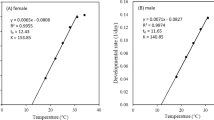Abstract
Out of the 2 important physical factors like temperature and relative humidity, the former plays significant role in affecting the survival of adults and development of immature stages ofCheiloneurus pyrillae Mani which is an important egg parasitoid of the sugarcane leaf hopper (Pyrilla perpusilla Walker) in India. Average longevity of males and females of this parasitoid decreased from 2.47 to 0.81 days and from 4.95 to 0.84 days, respectively when the test temperature was increased from 15 to 35±1.5°C. Similarly, its mean developmental period was found to reduce from a maximum of 45.87 to a minimum of 10.12 days when the rearing temperature was increased from 15 to 30±1.5°C. The parasitoid could not be reared at or above 32.5±1.5°C because its immature stages failed to withstand this temperature. These informations will be helpful in maintaining the mass culture ofC. pyrillae in the laboratory.
Résumé
Des 2 importants facteurs physiques que sont la température et l'humidité relative, le 1er joue un rôle significatif en affectant la survie des adultes et le développement des stades larvaires deCheiloneurus pyrillae qui est un important parasitoïde oophage de la cicadelle de la canne à sucre (Pyrilla perpusilla Walker) en Inde. La longévité moyenne des ♂ et des ♀ de ce parasitoïde décroissait de 2.47 à 0.81 jours et de 4.95 à 0.84 jours respectivement quand la θ test augmentait de 15 à 35±1.5°C.
De même, la période moyenne de développement passait d'un maximum de 45.87 à un minimum de 10.12 jours quand la θ d'élevage s'accroissait de 15 à 30±1.5°C. Le parasitoïde ne pouvait s'élever à une θ égale ou supérieure à 32.5±1.5°C, parce que ses stades larvaires ne pouvaient supporter cette θ. Cette information sera utile pour maintenir la culture de masse deC. pyrilla au laboratoire.
Similar content being viewed by others
References
Muliyil, J. A. &Lakshamanan, K. — 1942. The effect of conserving healthy and parasitised eggs ofPyrilla spp. in wire gauze cages on the population of the pest and its parasites. —Indian J. Entomol., 4, 221–223.
Narayanan, E. S. &Kundan Lal. — 1953. Studies on chalcid egg parasite ofPyrilla spp. occurring in Delhi. —Indian J. Entomol., 15, 173–179.
Solomon, M. E. — 1951. Control of humidity with potassium hydroxide and sulphuric acid or other solutions. —Bull. Entomol. Res., 42, 543–559.
Author information
Authors and Affiliations
Rights and permissions
About this article
Cite this article
Yadav, R.P., Chaudhary, J.P. Longevity and development of the egg-parasitoid,Cheiloneurus pyrillae [Hymenoptera: Encyrtidae] at different combinations of temperature and relative humidity. Entomophaga 31, 107–111 (1986). https://doi.org/10.1007/BF02372362
Received:
Accepted:
Issue Date:
DOI: https://doi.org/10.1007/BF02372362




